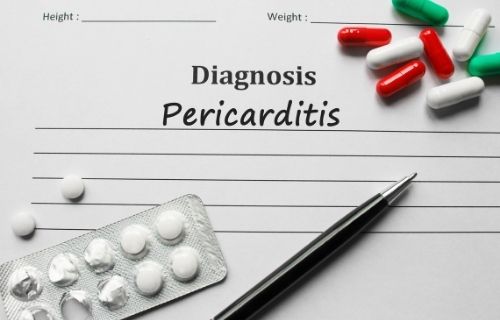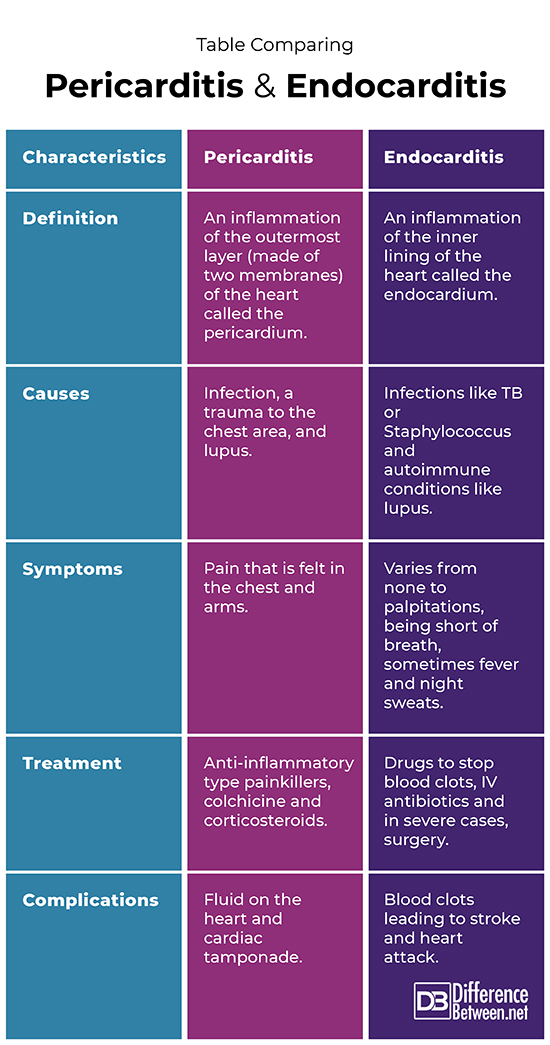Difference Between Pericarditis and Endocarditis
Pericarditis is inflammation of the membranes surrounding the heart muscle. Endocarditis is inflammation of the heart valves and other endothelial tissues of the heart.

What is Pericarditis?
Definition:
Pericarditis is defined as the medical problem where the membranes surrounding the cardiac tissues are inflamed.
Causes and risk factors:
There are a couple of reasons you could develop pericarditis. A heart attack or trauma that damages the heart could result in inflammation, or else an infection or having an illness like lupus where the body is attacking its own tissues. Males are more at risk than females when it comes to developing pericardial inflammation.
Diagnosis:
Diagnosis can be made using imaging methods like MRI, X-rays, or CT scans. An ECG tracing and listening for a pericardial rub can also indicate inflammation of the pericardium.
Symptoms:
Symptoms or pericarditis include pain, which is felt as a sharp ache in the center of the chest and arms. Pain in the chest is also made worse with breathing.
Complications:
A common complication of pericarditis is a buildup of fluid around the heart that can cause a problem called cardiac tamponade, which can result in death if not treated. In cardiac tamponade the heart can’t expand and contract properly because of the liquid between the membranes of the pericardium.
Treatment:
With mild pericarditis only pain killers, specifically anti-inflammatories are needed. Sometimes people also are given colchicine and corticosteroids. Fluid may need to be drawn off the heart if a lot of fluid accumulates.

What is Endocarditis?
Definition:
Endocarditis is an inflammatory condition that affects the endocardium (inner lining including the valves) of the heart.
Causes and risk factors:
There are many causes of endocarditis including cancer, the autoimmune disease lupus as well as infections like TB or pneumonia. Having infections such as TB or other bacterial infections are risk factors for later development of endocarditis. Other risk factors include being over the age of 60, having congenital heart problems, or possessing an implanted cardiac device or artificial valve.
Diagnosis:
Blood tests and echocardiograms can be done to help in diagnosing endocarditis. An echocardiogram can provide an image of the heart showing a problem in the structure and functioning of one or more heart valves. Blood tests may show a specific bacterial infection.
Symptoms:
Non-infective endocarditis may not have any symptoms and is not normally as bad or dangerous as infective endocarditis. Symptoms of endocarditis (for both infective and non-infective) might appear if there are noticeable deposits on the valves that have increased in size. These deposits are often called vegetations and can cause a problem with blood flow and heart function. Symptoms then include shortness of breath, a heart murmur, and on occasion, heart palpitations. With infective endocarditis, symptoms also include fever and night sweats.
Complications:
Patients may throw blood clots because of the valves malfunctioning, which can lead to stroke or heart attack. Where endocarditis is caused by infection, it may also result in septic shock and eventually, death.
Treatment:
Anticoagulant medicine helps stop blood clots forming if you have endocarditis. In the case of infective endocarditis additional medicine is needed that includes intravenous (IV) antibiotics and even surgery to repair valves. Infective endocarditis is dangerous and can lead to death. Patients may need to remain in the hospital for treatment and for careful monitoring of their condition.
Difference between Pericarditis and Endocarditis
Definition
The definition of pericarditis is an inflammatory problem of the pericardium. The definition of endocarditis is an inflammatory condition of the endocardium including the valves.
Causes
Pericarditis is caused by infection, or sometimes a trauma to the chest, or even illnesses like lupus. Endocarditis is caused by diseases like lupus or by infections (usually bacterial) like TB or Staphylococcus.
Symptoms
Pain is the main symptom of pericardial inflammation, and this is often also felt as pain in the arms and chest. Endocarditis has either no symptoms or has signs like palpitations, shortness of breath, fever, and night sweats.
Treatment
Pericarditis can sometimes be treated with painkillers that also help decrease inflammation, as well as by using colchicine or corticosteroid medications. Endocarditis can be treated using IV antibiotics, but sometimes surgical intervention is needed if valve deposits are seriously compromising cardiac function.
Complications
Pericarditis if untreated, can on the rare occasion, lead to complications like cardiac tamponade, which can result in death. Endocarditis can have complications such as blood clot formation, stroke, heart attack, septic shock, and death.
Table comparing Pericarditis and Endocarditis

Summary of Pericarditis and Endocarditis
- Pericarditis and endocarditis are both conditions in which some part of the heart is inflamed.
- Pericarditis is only when the outer membrane of the heart is inflamed.
- Endocarditis is specifically inflammation of the endocardium, including the valves of the heart.
FAQ
Can pericarditis lead to endocarditis?
Pericarditis that is a result of lupus can develop further into endocarditis.
What is the difference between pericarditis and myopericarditis?
Pericarditis is only inflammation of the pericardium while myopericarditis is when both the myocardium (muscle layer) and pericardium of the heart are inflamed.
What is the most common cause of endocarditis?
Endocarditis is most often due to a bacterial infection that has spread to the heart valves causing damage to the tissue.
- Difference Between Rumination and Regurgitation - June 13, 2024
- Difference Between Pyelectasis and Hydronephrosis - June 4, 2024
- Difference Between Cellulitis and Erysipelas - June 1, 2024
Search DifferenceBetween.net :
Leave a Response
References :
[0]Armstrong, Guy P. “Infective Endocarditis ”. Merck Manual, 2021, https://www.msdmanuals.com/professional/cardiovascular-disorders/endocarditis/infective-endocarditis
[1]Armstrong, Guy P. “Non-infective Endocarditis (Nonbacterial Thrombotic Endocarditis)”. Merck Manual, 2021, https://www.msdmanuals.com/professional/cardiovascular-disorders/endocarditis/noninfective-endocarditis
[2]Hoit, Brian D. “Pericarditis”. Merck Manual, 2021, https://www.msdmanuals.com/professional/cardiovascular-disorders/myocarditis-and-pericarditis/pericarditis
